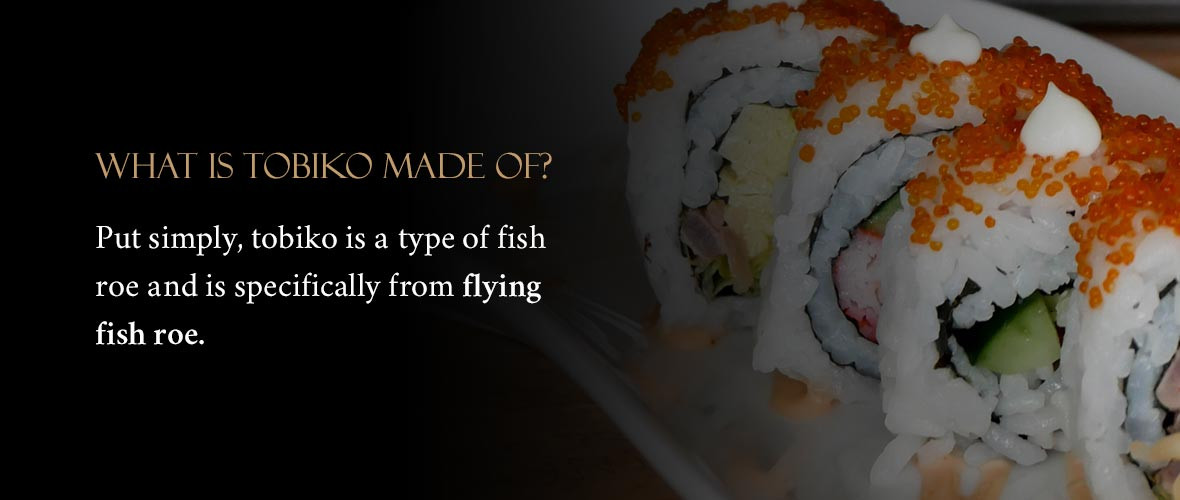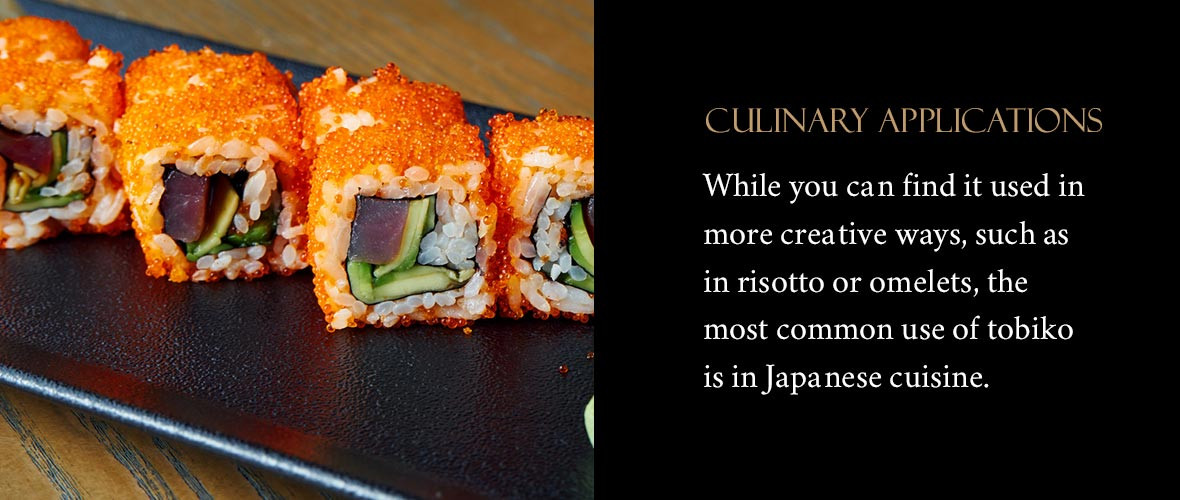The vibrant pop of color, the delicate shimmer, and the unmistakable crunch – tobiko is a fish roe that elevates dishes with its unique sensory appeal. You’ve likely encountered it topping sushi rolls, nestled on rice bowls, or as a garnish for sashimi. But what is tobiko exactly, and what makes flying fish roe so special in the culinary world?
Let’s delve into the distinctive characteristics of tobiko, sourced from flying fish, and discover what sets it apart from other types of roe. We’ll explore its origins, processing, the variety of flavors and colors it comes in, and how it compares to the luxurious caviar. Prepare to uncover the fascinating world of tobiko.
 Close-up view of vibrant orange tobiko, or flying fish roe, highlighting its natural color and small size.
Close-up view of vibrant orange tobiko, or flying fish roe, highlighting its natural color and small size.
Unpacking Flying Fish Roe: What Tobiko Is Made Of
In its simplest definition, tobiko is the roe, or eggs, of the flying fish. Several species of flying fish, inhabiting regions from the North Atlantic near Iceland to parts of the West Indies, produce tobiko. However, the most prized tobiko is frequently harvested from Cheilopogon agoo, the Japanese flying fish.
The production process of tobiko mirrors that of other roe varieties. Harvesters carefully extract the unfertilized eggs from female flying fish, meticulously removing any impurities. The roe then undergoes a salt curing process. This curing step is crucial, as it not only imparts a signature smoky flavor but also acts as a natural preservative, extending the shelf life of the delicate eggs. This process is key to achieving tobiko’s characteristic salty taste and satisfyingly crunchy texture.
Like most types of fish roe, tobiko requires proper storage to maintain its quality. It should be kept in an airtight container, ideally just above freezing temperatures. Tobiko eggs are remarkably small, typically less than 1 millimeter in diameter. Individually, their texture and flavor are subtle. This is why tobiko is typically enjoyed in generous portions, with each delightful bite containing dozens of tiny eggs, creating a more pronounced sensory experience.
When exploring the market for tobiko, you’ll notice a spectrum of colors available. One of tobiko’s unique attributes is its ability to readily absorb flavors. Consequently, it’s often cured, dyed, and infused with additional ingredients to create a variety of taste profiles and visual appeal. In its natural state, tobiko boasts a vibrant red-orange hue and a subtle citrusy undertone. However, chefs skillfully manipulate these characteristics to complement diverse dishes, resulting in an array of colored and flavored tobiko:
- Green Tobiko: This variation is infused with wasabi, delivering a noticeable spicy and sharp kick compared to natural tobiko. The green color is often enhanced with food dye for visual vibrancy. Green tobiko is typically created by curing and flavoring with a blend of sugar, salt, mirin, soy sauce, sake vinegar, and dashi.
- Black Tobiko: Black tobiko offers a distinct nutty umami flavor, derived from squid ink, which also lends it a deep black color. To intensify the black shade, some chefs may incorporate blue, red, and yellow food dyes in combination with squid ink.
- Yellow Tobiko: Infusing tobiko with citrus fruits like yuzu imparts a bright, zesty flavor and a pale yellow color. Yellow food dye is sometimes used to achieve a more pronounced yellow hue.
- Red Tobiko: The red color in some tobiko varieties is achieved through natural ingredients like chili or beets. Chili-infused tobiko offers a spicy flavor profile, while beet-infused tobiko provides a milder, slightly sweet taste.
- Golden Tobiko: For those seeking the purest tobiko experience, golden tobiko is the ideal choice. This type is simply cured with salt, without any added dyes or flavorings, allowing the natural, slightly briny flavor of the flying fish roe to shine through.
The type of tobiko you encounter in a restaurant setting is carefully selected to complement the specific dish, acting as a flavor enhancer rather than the primary component.
Exploring Tobiko’s Relatives: Other Types of Fish Roe
It’s important to note that tobiko is just one member of the diverse family of roe used in Japanese cuisine. Its size, color, and texture can sometimes lead to confusion with other popular varieties. Here are a couple of tobiko’s “cousins” to clarify their differences:
- Masago: These eggs are derived from smelt roe or capelin roe and are even smaller than tobiko. The primary distinction between masago and tobiko lies in texture. Masago tends to be less refined, often described as grainier or sandier, with a milder flavor profile. Many find masago to have a slightly bitter taste compared to tobiko. Like tobiko, masago can be colored and flavored through curing and dyeing.
- Ikura: Ikura eggs, which are salmon roe, are significantly larger and sweeter than tobiko, boasting a distinctive orange color. These individual beads are easily discernible on the palate and deliver a satisfying “pop” when pressed against the roof of the mouth. Ikura is popular in both Russian and Japanese cuisines.
Nutritionally, tobiko and its roe relatives are surprisingly beneficial, despite being low in calories. They are known to be rich sources of protein and healthy Omega-3 fatty acids. However, their sodium and cholesterol content suggests moderation is key. When consumed in reasonable amounts, tobiko roe contributes valuable vitamins, minerals, and nutrients to a balanced diet.
Next time you enjoy a meal at a Japanese restaurant, pay close attention to the various types of crunchy roe gracing your plate. Experiencing them firsthand is the best way to appreciate their unique qualities.
 Tobiko generously garnished on sushi dishes, showcasing its culinary versatility and vibrant color as a topping.
Tobiko generously garnished on sushi dishes, showcasing its culinary versatility and vibrant color as a topping.
Culinary Versatility: How Tobiko is Used
Tobiko’s culinary applications are wide-ranging. Its smooth, slightly creamy texture and delicate, smoky-sweet flavor make it an excellent complement to savory and salty dishes. While innovative chefs may incorporate it into dishes like risotto or omelets, tobiko is most commonly found in Japanese cuisine.
If you’re a sushi enthusiast, you’re likely familiar with tobiko’s pivotal role. That signature crunch is a defining characteristic, providing a delightful contrast to the smooth and creamy textures within nigiri or maki. Sometimes, tobiko even takes center stage in a maki roll known as tobiko gunkan maki. This sushi variety is shaped like a ship, or “gunkan.”
Gunkan maki is crafted by wrapping a strip of seaweed around a small mound of rice, creating a well to hold the tobiko topping. Occasionally, a quail egg yolk is added for an extra touch of richness and visual elegance.
Flavor-wise, tobiko’s subtle smokiness harmonizes beautifully with fresh fish, sushi rice, nori seaweed, salads, and vegetables commonly found in sushi. Given the diverse styles of sushi, the various types of tobiko offer versatile additions to sushi meals. In sushi rolls, tobiko is often sprinkled on the outer layer of rice, as seen in California rolls, which is often the first tobiko experience for many.
Furthermore, tobiko enhances sashimi dishes. Sashimi, simple yet exquisite, features thinly sliced raw fish. It’s typically served with soy sauce for dipping and may include tobiko as a garnish, often presented atop sliced avocado or similar ingredients. This allows diners to add a touch of tobiko to each bite of sashimi.
It’s worth noting that tobiko is best appreciated as part of a dish, rather than eaten on its own. Its flavor profile, while pleasant, is not complex enough to stand alone. However, its remarkable ability to elevate your favorite Japanese dishes is something to keep in mind when ordering your next plate of sushi or sashimi. Depending on the color and flavor of tobiko served, you can anticipate a delightful enhancement to your meal.
Tobiko Compared to Caviar
How does tobiko measure up against caviar? In truth, caviar occupies a different echelon of culinary experience, and seasoned connoisseurs generally wouldn’t draw a direct comparison to tobiko. While both are categorized as fish eggs, the similarities largely end there. What truly distinguishes tobiko from caviar?
Caviar, in the strictest sense, is the exclusive salt-cured roe of the sturgeon family, encompassing majestic species like beluga, kaluga, sevruga, and others. These sturgeon are rare, large fish that require many years to mature before yielding eggs suitable for caviar production. In fact, it can take over a decade for a female sturgeon to produce high-quality caviar. Furthermore, the harvesting and processing of caviar demand exceptional skill and meticulous care. The eggs must be handled with utmost delicacy, and the curing process is equally precise.
When caviar graces a plate—or more accurately, a mother-of-pearl spoon—it presents an extraordinary spectrum of nuanced flavors and textures, often described as luxurious. The pearls are substantial and lustrous, displaying distinctive colors and patterns ranging from steely gray and bronze to earthy greens and gold.
This is why caviar is traditionally served with minimal accompaniments and paired with a crisp, dry white wine or Champagne. Attending a caviar tasting is a sensory experience, captivating everyone in the room. Caviar is not simply eaten; it is savored and appreciated.
This isn’t to diminish tobiko’s value and place in cuisine, but rather to emphasize that caviar represents a unique and exceptionally refined culinary treasure.
Shop Authentic Sturgeon Caviar
Discover Top-Quality Caviar at Imperia Caviar
As you’ve learned, tobiko and caviar occupy different spheres in terms of taste, texture, exclusivity, and price. The experience of enjoying caviar is unparalleled, akin to appreciating a fine wine, whiskey, or cigar. Years of cultivation and meticulous production are essential to create the final product, and it should be enjoyed with commensurate appreciation.
If your curiosity is piqued by tobiko or salmon roe, you owe it to yourself to explore the exquisite world of caviar. Imperia Caviar sources its caviar from sustainable aqua farms, offering a selection of premium caviar delivered directly to your doorstep at exceptional prices. One taste of Imperia Caviar is truly all it takes to understand the difference.
 Top-Tier Caviar From Imperia Caviar
Top-Tier Caviar From Imperia Caviar
Last Updated 9/8/22
SHOP NOW
